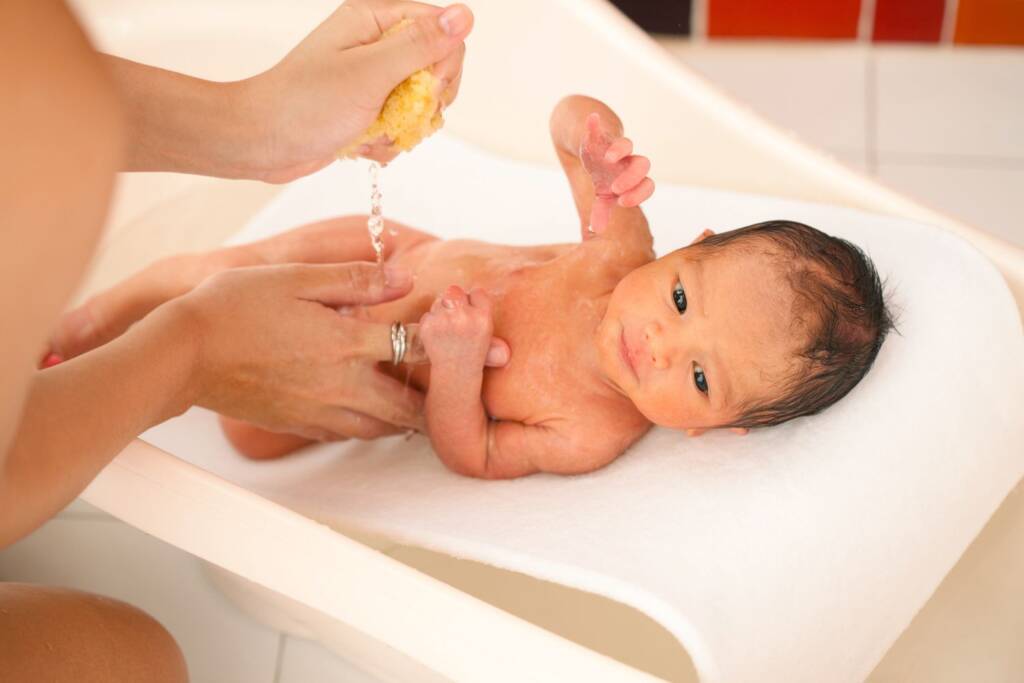Bathing a newborn is a significant aspect of baby care that can be both joyful and daunting for new parents. Proper bathing practices ensure the baby’s hygiene and comfort while providing an opportunity for bonding. This comprehensive guide covers essential tips and tricks for new parents, helping them navigate the challenges of newborn bathing with confidence and ease.
Preparing for the First Bath
Gathering Essential Supplies
Before the first bath, gather all necessary supplies. You’ll need a baby bathtub, mild baby soap, a soft washcloth, a towel, clean clothes, and a fresh diaper. Having everything within reach ensures a smooth and stress-free bath time.
Choosing the Right Time and Place
Select a time when your baby is calm and not hungry or too tired. A warm, draft-free room is ideal. Ensure the space is clean and safe, with all supplies laid out and ready to use.
Creating a Safe Bathing Environment
Safety is paramount. Use a non-slip mat in the bathtub and ensure the room temperature is warm to prevent your baby from getting cold. Always keep one hand on your baby to prevent slipping and have everything you need within arm’s reach.
Types of Newborn Baths
Sponge Baths
Sponge baths are ideal for newborns until their umbilical cord stump falls off. Use a damp washcloth to gently clean your baby, focusing on the face, neck, and diaper area.
Tub Baths
Once the umbilical cord stump has healed, you can transition to tub baths. Use a small, infant-sized bathtub filled with a few inches of warm water.
Sink Baths
Sink baths can be convenient for new parents. Ensure the sink is clean and use a padded insert to provide support and comfort for your baby.
Bathing Safety Tips
Water Temperature and Testing
The water temperature should be around 100°F (37.8°C). Use a bath thermometer to check the water temperature, or test it with your elbow or wrist to ensure it’s warm but not hot.
Supporting the Baby
Support your baby’s head and neck with one hand while using the other to bathe them. Ensure your baby is always within your grasp to prevent slipping.
Keeping the Baby Warm
Keep your baby warm during the bath by pouring warm water over their body regularly. After the bath, wrap your baby in a hooded towel to dry them off quickly and keep them warm.

Bathing Frequency and Routine
How Often to Bathe a Newborn
Newborns don’t need daily baths; two to three times a week is sufficient. Over-bathing can dry out their delicate skin. Focus on keeping the diaper area, face, and neck clean daily.
Establishing a Bathing Routine
Create a consistent bathing routine to provide a sense of security and predictability for your baby. Bathing at the same time each day, preferably before bedtime, can help signal that it’s time to wind down.
Balancing Bathing with Skincare Needs
Use gentle, baby-friendly products to maintain your baby’s skin health. Avoid harsh soaps and ensure you rinse off all soap residues to prevent skin irritation.
Choosing Bathing Products
Baby-Friendly Soaps and Shampoos
Choose mild, hypoallergenic soaps and shampoos designed for babies. Look for products that are free of fragrances and dyes, which can irritate sensitive skin.
Importance of Hypoallergenic Products
Hypoallergenic products reduce the risk of allergic reactions and skin irritations. Always check the labels and opt for trusted, pediatrician-recommended brands.
Avoiding Harsh Chemicals
Avoid products with harsh chemicals like parabens, phthalates, and sulfates. Natural, organic options can be gentler on your baby’s skin.
Step-by-Step Bathing Guide
Preparing the Bath
Fill the bathtub with 2-3 inches of warm water. Gather all necessary supplies within arm’s reach and ensure the room is comfortably warm.
Washing the Baby
Start by gently washing your baby’s face with a damp washcloth, using only water. Move on to washing their hair with a small amount of baby shampoo, then rinse thoroughly. Clean the rest of the body, paying special attention to folds and creases.
Rinsing and Drying
Rinse your baby with clean, warm water to remove all soap. Lift your baby out of the bath, supporting their head and neck, and wrap them in a soft towel. Pat the skin dry, avoiding vigorous rubbing.
Handling Common Bathing Challenges
Bath Time Fussiness
Some babies may fuss during bath time. Keep calm, speak softly, and ensure the bath is warm and comfortable. Distractions like toys and gentle splashing can help.
Cradle Cap Care
Gently wash your baby’s scalp with a mild shampoo to help loosen cradle cap flakes. Use a soft brush to remove any loose flakes gently.
Dry Skin and Eczema
For dry skin and eczema, limit bath time to 10 minutes and use lukewarm water. Apply a gentle, hypoallergenic moisturizer immediately after the bath to lock in moisture.
Post-Bath Care
Moisturizing the Baby’s Skin
After drying, apply a baby-friendly moisturizer to keep the skin soft and hydrated. Choose a product that is free of fragrances and harsh chemicals.
Diapering and Dressing Tips
Ensure the diaper area is completely dry before putting on a fresh diaper to prevent diaper rash. Dress your baby in comfortable, breathable clothing.
Creating a Comfortable Post-Bath Environment
After the bath, create a soothing environment with dim lights and soft music. This can help your baby relax and prepare for sleep.
Bonding During Bath Time
Importance of Physical Contact
Bath time is an excellent opportunity for skin-to-skin contact, which promotes bonding and emotional security.
Singing and Talking to Your Baby
Sing and talk to your baby during the bath. Your voice is soothing and helps build your baby’s language skills.
Making Bath Time Fun and Relaxing
Introduce bath toys and play gentle games to make bath time enjoyable. Keep the atmosphere calm and relaxed to ensure a positive experience.
Bathing Different Ages
Bathing a Newborn (0-3 months)
Newborns need gentle, brief baths. Use a soft washcloth and ensure the bath area is warm and draft-free.
Bathing an Infant (3-6 months)
As your baby grows, you can introduce more water play and bath toys. Ensure they are supported and safe in the tub.
Bathing an Older Baby (6-12 months)
Older babies can sit up and enjoy more interactive bath time. Always supervise closely and ensure the water depth and temperature are safe.
Special Bathing Situations
Bathing a Preemie
Preemies have delicate skin and need extra gentle care. Use lukewarm water and minimal soap, ensuring the bath is brief and soothing.
Bathing a Baby with Special Needs
Adapt your bathing routine to meet your baby’s specific needs. Consult with healthcare providers for personalized advice and support.
Bathing a Baby with a Cold or Illness
When your baby is sick, keep baths short and use warm, not hot, water. Avoid bath time if your baby is very unwell and consult your pediatrician for guidance.
Tips for Dads and Other Caregivers
Getting Involved in Bath Time
Encourage dads and other caregivers to participate in bath time. It’s a great bonding experience and helps share the responsibilities.
Building Confidence in Bathing Skills
Practice makes perfect. Caregivers can build confidence by taking turns and supporting each other during bath time.
Sharing Responsibilities
Divide bath time duties to ensure everyone gets involved. This not only helps with bonding but also lightens the load.
Cultural Bathing Practices
Traditional Bathing Methods Around the World
Explore different cultural bathing practices. Some cultures use herbal baths, while others may have specific routines for baby care.
Incorporating Cultural Practices into Bath Time
Incorporate safe, traditional practices into your routine to honor your cultural heritage.
Respecting Cultural Differences
Respect and learn about different cultural practices. What works for one family may differ for another, and that’s perfectly okay.
Using Bath Time to Teach
Introducing Water Play and Learning
Water play is an excellent opportunity for learning. Use cups and toys to teach pouring and floating concepts.
Developing Sensory Skills
Bath time stimulates your baby’s senses. Encourage splashing and playing with different textures to enhance sensory development.
Encouraging Curiosity and Exploration
Allow your baby to explore and be curious during bath time. This fosters a love for learning and discovery.

Bathing Accessories and Tools
Bath Seats and Supports
Use bath seats and supports to keep your baby safe and comfortable. These tools provide stability and allow you to have both hands free.
Thermometers and Washcloths
Invest in a good bath thermometer to ensure water temperature is safe. Soft washcloths are gentle on your baby’s skin.
Bath Toys and Entertainment
Bath toys make bath time fun and engaging. Choose safe, non-toxic toys that are easy to clean.
Travel and Bathing
Bathing While Traveling
When traveling, maintain your baby’s routine by bringing portable bathing solutions like inflatable tubs or foldable bath seats.
Portable Bathing Solutions
Portable baths are convenient for travel. They are lightweight, easy to pack, and provide a familiar bathing environment.
Maintaining Routine on the Go
Stick to your baby’s regular bath time routine as much as possible to provide a sense of normalcy and comfort.
Eco-Friendly Bathing Practices
Choosing Sustainable Bathing Products
Opt for eco-friendly bathing products that are gentle on your baby and the environment. Look for biodegradable and natural ingredients.
Reducing Water Usage
Be mindful of water usage by filling the tub with only as much water as necessary and avoiding long baths.
Recycling and Reusing Bathing Accessories
Choose bath toys and accessories made from recycled materials. Reuse items when possible and dispose of them responsibly.
Bath Time Myths and Facts
Debunking Common Myths
Address common myths about newborn bathing, such as the idea that daily baths are necessary or that cold water is better for the baby.
Understanding the Facts
Provide factual information based on pediatric guidelines and expert advice to help parents make informed decisions.
Making Informed Bathing Choices
Encourage parents to research and choose bathing practices that best suit their baby’s needs and their family’s lifestyle.


